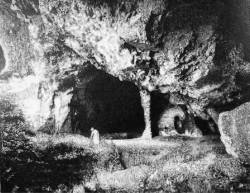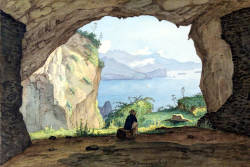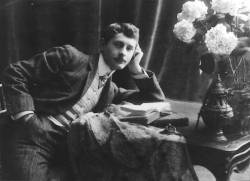Grotta Matromania
Grotta di Matromania - Grotta di Matermania
Useful Information

| Location: |
Eastern coast of Capri island.
From the center of the village Capri follow Via Le Botthege to the east, then turn right into Via Matermania.
The final part of this road is called Via Arco Naturale, at its end a trail to the cave starts.
(40.5493094915626, 14.255833006783979) |
| Open: |
no restrictions. [2012] |
| Fee: |
free. [2012] |
| Classification: |
 Karst Cave Karst Cave
|
| Light: | bring torch |
| Dimension: | L=35 m, W=18 m, H=10 m. |
| Guided tours: | self guided |
| Photography: | allowed |
| Accessibility: | no |
| Bibliography: | |
| Address: | Azienda Autonoma Soggiorno Cura E Turismo, Via Padre Serafino Cimmino, 1, 80073 Capri NA, Tel: +39-081-837-0424. |
| As far as we know this information was accurate when it was published (see years in brackets), but may have changed since then. Please check rates and details directly with the companies in question if you need more recent info. |
|
History
| ~1917 | hermit monk Miradois settled in the cave. |
| 25-AUG-1910 | tableau vivant in the cave by baron Jacques d’Adelswärd-Fersen. |
Description

The Grotta di Matromania is a natural cave with heavy artificial alterations. It contains the remains of Roman walls and a sort of amphitheatre cut out of the rock. The place was used as a Nymphaeum, a monument consecrated to the nymphs. Natural grottoes were during antiquity thought to be habitations to the local nymphs. But while they were seen as sacral places during pre-Roman times, the Romans started also to see their recreational use.
According to local legend the cave was used for the worship of Kybele, Goddess of Earth, and Mitra, God of the Sun. It was actually named after Kybele, the Phrygian goddess of nature and animals was called Mater Magna, which became Matromania. However, others say it was named after Mitra, and was originally Mitromania. According to legend the worship included human sycrifices, but this is most likely a Christian denigration, meant to discredit the competition. However, the worship was ended by emperor Augustus, who ordered the transformation of the cave. It was decorated with mosaics and shells, and it was used as a water reservoir.
Since Roman times the decorations were destroyed and the cave today shows only ruined remains of the walls and the chiseled walls. The statuette of the goddess Cybele and the relief of the god Mithras which were excavated in the cave are kept at the National Archaeological Museum of Naples. In recent years the cave became known as the Marriage Cave. Young Capri couples, after getting married, went to the cave as a propitiatory rite before the lunch set up in the bride’s house. And there are some really strange stories about the cave from the early 20th century.

On the night of 25-AUG-1910, the French baron Jacques d’Adelswärd-Fersen (*20-FEB-1880 Paris; ✝05-NOV-1923 Capri) set up a tableau vivant in the cavity, in the presence of some of his friends and servants. The cave was illuminated by numerous torches and scattered with carpets and cushions, A small altar was placed in the middle of the cavern. The party included theatrical shows with Fersen playing handsome young Hypatos and Nino Cesarini, his boyfried, playing the role of a soldier of Mithra. The party lasted all night until dawn, when the carabinieri arrived and arrested those present. The police was called by the neighbours, who had noticed strange activities around the cave for a few days. Baron Fersen left the island to avoid the scandal and the shame of the expulsion, and went to stay in Naples with his sister.
The reality behind the story is a little different. Fersen was gay, quite a problem at this time. He made parties which included poetry and impersonation, but also young boys. They were called black masses by his enemies and Fersen imprisioned in 1903 and later convicted to six months in prison, 50 francs fine and he lost civil rights for five years. He went to Capri and built a villa, but in 1909 he published a novel about Capri named Et le feu s’éteignit sur la mer… (’And the fire was smothered by the sea’). But as Jacques wrote quite frivolously about Capri habits and morals, islanders, recognising themselves in the book, decided to pursue his expulsion from the island. The parties in the Grotta di Matromania were again exaggerated. The authorities asked his brother-in-law, marquis Alfredo di Bugnano, who was married to his sister Germaine, to intervene. The marquis summoned him to Naples and presented him with two options, either to leave Italy voluntarily or be expelled officially. He left the country for several years but returned during World War I.
Gustavo Giulio Ottone Dobrich, known to all as Miradois, was a hermit monk who arrived on the island shortly before the end of World War I. After wandering through various sites, he settled in the cave. He was living off the roots and herbs he found, and milk of a single adopted goat among those that lived free in the surroundings. When he left the island, he wrote a document with which he "donated" the cave to the town of Capri. He also made a detailed inventory of what he had left in it and which included: "Four stone beds, eight sand and limestone cushions, four walls and the sun".
- See also
 Search DuckDuckGo for "Grotta Matromania"
Search DuckDuckGo for "Grotta Matromania" Google Earth Placemark
Google Earth Placemark Ferdinand Gregorovius, Wanderjahre in Italien, Die Insel Capri 1853
Ferdinand Gregorovius, Wanderjahre in Italien, Die Insel Capri 1853 Capri Tourism (visited: 09-MAY-2012)
Capri Tourism (visited: 09-MAY-2012) Capri - Arco Naturale and Pizzolungo (visited: 11-JUN-2012)
Capri - Arco Naturale and Pizzolungo (visited: 11-JUN-2012) Storie capresi di Luigi Lembo – Miradois e la grotta di Matermania
Storie capresi di Luigi Lembo – Miradois e la grotta di Matermania  (visited: 23-APR-2021)
(visited: 23-APR-2021)
 Index
Index Topics
Topics Hierarchical
Hierarchical Countries
Countries Maps
Maps